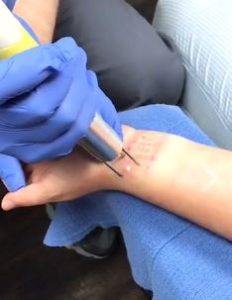What Laser Tattoo Removal is Really Like
The following post is written by one of our patients who has graciously shared her story about laser tattoo removal at Naaman Clinic. You can see a real demonstration of one of her tattoo removal treatments here.

In 2011, I decided to get a tattoo while I was on a trip to the mountains. It was simple, and I was so in love with it: the word “faith” on my left wrist in a thick black script. At the time, I was working in the beauty industry, and visible tattoos were all over my workplace. Fast-forward four years into the future, and the tattoo that I still love just doesn’t fit my lifestyle anymore. Now, as a nursing student, I feel compelled to cover up my tattoo every day when I’m in class or working. I got so sick of covering it up that I turned to laser tattoo removal at Naaman Clinic.
I had heard all of the typical horror stories related to laser tattoo removal: it’s incredibly painful, time-consuming and that it just isn’t very effective. But I ignored all of the rumors and decided to talk to Dr. Bailey at Naaman Clinic, whom I was working for at the time. Coincidentally, Dr. Bailey had just recently received his new laser: a Quanta Q-Switch laser that is especially good at removing tattoos. After speaking with Dr. Bailey, I decided to move forward with having my tattoo removed.
We started out by getting numbing shots around and through the lettering of my tattoo. Honestly this is the toughest part, but the numbing fluid goes to work almost instantly. These shots are the same that Dr. Bailey uses for a surgery or biopsy, so they’re pretty heavy-duty. Since my tattoo is relatively small (the length of the width of my wrist), it doesn’t take long to complete this part of the procedure. The longest part is just waiting to ensure that all the fluid has completely settled in.
Next, Dr. Bailey comes in and we put on protective eyewear. The laser “warms up” and makes a humming sound. Dr. Bailey takes lots of pictures of the tattoo and the surrounding area to make sure everything is progressing properly. Then he enters the settings he used on my previous treatment and starts there. He traces the lettering of my tattoo with a hand-held applicator attached to the laser machine. It’s roughly the size of a remote control for a television and it hovers over my skin as it makes popping sounds. It can be somewhat loud at times, but I don’t feel anything at all. My time under the laser is probably only four or five minutes, tops. A lot of that time is really just Dr. Bailey calibrating the laser to get the best results.
Within a total of twenty to thirty minutes, I’m done with my appointment, and I’ll schedule another treatment for about four weeks later. Within that four week period, my tattoo will gradually fade a little more and scab over in certain spots. It can be a little itchy at times, but I’ve never experienced any real pain.
Since my first treatment, I’ve been back three different times. I’ll probably have two or three more treatments until I’m totally finished since most people go through six treatments total. The number of treatments is entirely unique to the person, type of tattoo, location of tattoo, etc., but Dr. Bailey was careful to give me my estimate during my initial consultation.
Halfway through this process, I can’t express how glad I am that I took the plunge. I’m so glad that I didn’t get hung up on the myths about pain and how time-intensive the process is. Honestly, I’ve had so many people that are curious about the process ask me about it and they’re shocked to learn that it’s so simple and so effective. It’s sort of still shocking to me sometimes to see how faded my tattoo is now compared to how bold it was initially. I’m so happy with my results thus far!
If you’re considering having a tattoo removed, I advise you to ask yourself if you really still want it or not. My motto is “If you have a doubt, throw it out.” I was definitely doubting my tattoo, and I’m so happy that I decided to throw it out!
